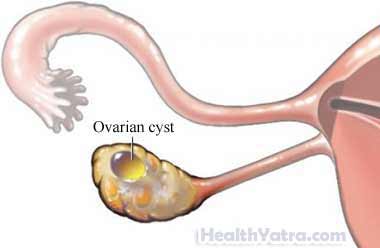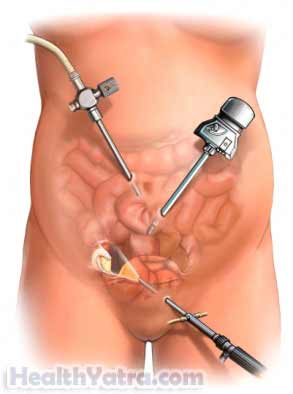Definition
This is surgery to remove a cyst on an ovary.

Reasons for Procedure
An ovarian cyst may need to be removed if it is:
- Suspected of being cancerous (the chances are lower if you are young)
- Large (more than 2.5 inches in diameter)
- Solid (rather than containing just fluid)
- Causing pain
Possible Complications
Complications are rare, but no procedure is completely free of risk. If you are planning to have an ovarian cyst removed, your doctor will review a list of possible complications, which may include:
- Infection
- Bleeding
- Cyst returns after it is removed
- Need for removal of one or both ovaries
- Infertility
- Blood clots
- Damage to other organs
Factors that may increase the risk of complications include:
- Obesity
- Chronic or recent illness
- Heavy use of alcohol, smoking, or use of narcotics (may make delivering anesthesia more difficult or impair wound healing)
- Use of certain prescription medicines
- Pregnancy
- Previous abdominal surgery
Be sure to discuss these risks with your doctor before the procedure.
What to Expect
Prior to Procedure
Your doctor may do the following:
- Physical exam
- Review of medicines
- Blood tests
- Urine test
- CT scan —a type of x-ray that uses a computer to make pictures of organs
- Ultrasound —a test that uses sound waves to examine the abdomen
- Electrocardiogram (ECG, EKG)—a test that records the heart’s activity by measuring electrical currents through the heart muscle
Talk to your doctor about what action should be taken if cancer is found during surgery. One option is to remove the ovary.
Leading up to the surgery:
- Talk to your doctor about your medicines. You may be asked to stop taking some medicines up to one week before the procedure, like:
- Aspirin or other anti-inflammatory drugs
- Blood thinners, such as warfarin (Coumadin)
- Clopidogrel (Plavix)
- Arrange for a ride to and from the hospital. Also, arrange for someone to help you at home.
- Do not eat or drink for at least eight hours before the surgery.
Anesthesia
- General anesthesia —blocks pain and keeps you asleep through the surgery; given through an IV in your hand or arm
- Local anesthesia—just the area that is being operated on is numbed; given as an injection and may also be given with a sedative
Description of the Procedure
The doctor will make a small incision just below the navel. Next, the doctor will insert a laparoscope. This is a thin tube with a camera on the end. To allow the doctor to better view the organs, carbon dioxide gas will be pumped into the abdomen. The laparoscope will be used to locate the cyst. Once found, the doctor will make one or two more incisions. Surgical tools will be inserted to remove the cyst. The doctor may remove tissue for testing. If cancer is found, both ovaries may need to be removed. Once the cyst is removed, the doctor will remove the tools. The incision area will be closed with stitches or staples.
In some cases, the doctor may switch to an open surgery. He will make a large incision in the abdomen to do the surgery.

Immediately After Procedure
After the procedure, you will be given IV fluids and medicines while recovering.
How Long Will It Take?
1-2 hours
Will It Hurt?
There will be pain after the surgery. Your doctor will give you pain medicine.
Average Hospital Stay
You may stay overnight, or you may be able to leave the hospital the same day as your surgery.
Post-procedure Care
Recovery may take 1-2 weeks. When you return home, do the following to help ensure a smooth recovery:
- Be sure to follow your doctor’s instructions .
- Ask your doctor about when it is safe to shower, bathe, or soak in water.
- Gently wash the incision area with mild soap and water.
- Move and elevate your legs while in bed. This will lessen the chance of blood clots.
- Take prescription pain medicine only for as long as needed. Take over-the-counter pain relievers (eg, ibuprofen , naproxen ) if the pain is mild.
- Avoid strenuous exercise for 2-6 weeks.
- Do not drive until your doctor says it is safe.
- Do not resume sexual activity until your doctor says it is okay. You may need to wait two weeks.
- Follow your doctor’s guidelines for ultrasound tests. These may need to be done if it is likely that the cysts will return.
Call Your Doctor
After you leave the hospital, contact your doctor if any of the following occurs:
- Signs of infection, including fever and chills
- Redness, swelling, increasing pain, excessive bleeding, or discharge from the incision site
- Pain that you cannot control with the medicines you have been given
- Increased vaginal bleeding or discharge
- Cough, shortness of breath, chest pain
- Nausea and/or vomiting that you cannot control with the medicines you were given after surgery, or which persist for more than two days after discharge from the hospital
- Headaches, muscle aches, dizziness, or general ill feeling
- Constipation or abdominal swelling
- Vomiting
- Urinary difficulties
- Onset of pain or swelling in one or both legs
- New, unexplained symptoms
In case of an emergency, call for medical help right away.
